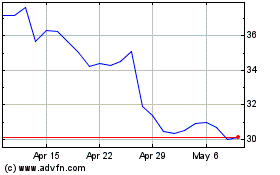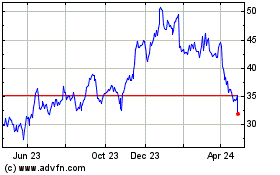Intel Moves to Lock Down Business PCs
January 19 2016 - 5:30PM
Dow Jones News
SAN FRANCISCO—Intel Corp. announced a new effort to use security
and computing performance to sell a new generation of
microprocessor chips.
The Silicon Valley company said a new technology, dubbed
Authenticate, is built into new versions of its Core line of chips
that are aimed at business PCs. Intel said the technology can make
it much easier for companies to require that up to four safeguards
be in place before users can log onto their computer, a technique
called multifactor authentication, rather than a single factor such
as a password.
For example, a company could require any combination of a
password, a fingerprint scan or the presence nearby of an
authorized employee smartphone that a PC could sense using
Bluetooth technology, Intel said. It could also require users to
enter a set of numbers on a PC touch screen, thwarting potential
threats from malicious software that monitors their typing on
keyboards, the company said.
A key feature of the Authenticate technology is that the
identifying elements and company security policies aren't stored on
a computer's disk drive or another traditional storage device,
where they would be vulnerable to a variety of attacks on a PC's
operating system or other software, Intel said. Instead, the
factors are stored on a special protected zone on the
microprocessor.
Intel noted that, apart from companies' growing security
worries, users dislike remembering and managing passwords. "From
their perspective, this is a huge win," said Tom Garrison, an Intel
vice president, during a briefing in San Francisco to announce the
new chips.
The technology works with Microsoft Corp.'s Windows 10, Windows
8 and Windows 7 operating systems. Intel said it is letting
companies test Authenticate and provide feedback on how it works
before announcing its general availability.
Intel's move is the latest in a series of solutions offered by
technology companies in hopes of stemming the seemingly intractable
problem of computer attacks, which frequently are linked to
organized criminals or intelligence agencies. However, Intel is in
an unusually influential position to help popularize solutions
because it supplies chips that provide computing power to more than
90% of all PCs.
The chip maker for years has offered hardware features that work
alongside security software as part of a 10-year-old effort called
vPro. Those have included ways to establish that a PC, or portions
of it, haven't been modified.
In contrast, Intel's latest effort primarily targets the issue
of stolen passwords, a major cause of security breaches. Users
frequently are duped into giving up those credentials when they
visit a booby-trapped website or open an email that contains
malware that can hunt for passwords.
Only by removing passwords does the problem go away, said
Patrick Moorhead, an analyst at Moor Insights & Strategy.
"No technology is unbreakable, said Bob O'Donnell, an analyst at
Technalysis Research. "But this takes security to a whole new
level," he said.
Other people briefed on Intel's technology say it will take a
long time to have an impact. For one thing, businesses for decades
have built their security practices around managing passwords.
"They are just not ready," said Maribel Lopez, founder of the
market research firm Lopez Research.
Intel said its new chips, the sixth generation of its Core
family, offer up to 2.5 times the computing performance of a
five-year-old PC. It didn't provide a comparison with recent
chips.
Intel's news on Tuesday coincided with the kickoff of a new
television advertising campaign designed to highlight priorities of
Brian Krzanich, who became chief executive in May 2013 and has
pushed the company to move beyond PC chips. The new ads attempt to
show how the company, known for its "Intel Inside" slogan, also
affects the outside world, as shown by selected artists, dancers,
musicians and clothes designers, the company said. Intel didn't
disclose the cost of the campaign.
Write to Don Clark at don.clark@wsj.com
(END) Dow Jones Newswires
January 19, 2016 17:15 ET (22:15 GMT)
Copyright (c) 2016 Dow Jones & Company, Inc.
Intel (NASDAQ:INTC)
Historical Stock Chart
From Mar 2024 to Apr 2024

Intel (NASDAQ:INTC)
Historical Stock Chart
From Apr 2023 to Apr 2024
